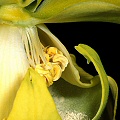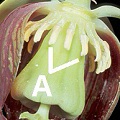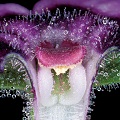Q: My plant is flowering! What do I do?

Sarracenia flava
A: First, take satisfaction in the fact you successfully grew a challenging
plant to flowering
size. Now you can attempt to fertilize the plant. Many carnivorous plants can be easily
fertilized. The sexual organs in the genera
Drosera, Byblis, Drosophyllum, and Dionaea are easily identified.
Consult a beginning botany textbook and identify the stigma and anthers.
Take pollen from the anthers and gently dab it on the
stigma. Many
carnivorous plants can be "selfed." This means transferring
a flower's own pollen to its stigma.
The floral structures of Sarracenia and Darlingtonia
are a little peculiar. Look at the picture of Sarracenia flava to the
right (one drooping yellow petal has been removed for clarity). The cluster
of dangling yellow-orange anthers is obvious enough. You can see the
pollen collecting below in the big, inverted umbrella like structure. That
big umbrella structure is a huge, modified style (female stuff). The receptive
stigmatic surface is that little hook that points downward, on the modified
style.
If you are still confused, make sure you click the Sarracenia flava
flower for a closer look. To pollinate this plant, you must
transfer the pollen to the stigmatic surface.

Darlingtonia

Pinguicula sex bits
Somewhat similar in floral structure are the flowers of
Darlingtonia.
To the right you can see a partially de-petalled
Darlingtonia flower. I have indicated the anthers with an "A" and
the receptive stigmatic surfaces with a "B". You have to click
on the thumbnail to see the letters.
You want to apply pollen to the five tips of the stigmatic surface.
Venus flytraps (Dionaea) can be selfed although they
do not always produce seed. Furthermore, seed production often tires the
plant noticeably. (I break off flower stalks whenever they appear.)
Read the
Venus flytrap section of the FAQ for more chiding
information about why you should not let your Venus flytraps flower.
The floral structures of Pinguicula, Utricularia, and Genlisea
are all very similar, which is why they are in the same plant family,
Lentibulariaceae. At the right is an image of the sex organs of
Pinguicula moranensis. To reveal them to your gaze,
I brashly tore off the delicate underpetals in a fit
of passion, then lunged forward with my camera gear while the exposed floral
structures quivered in delight. The front of the flower is at the top. Notice the
two white curving stamens tipped with globs of yellow pollen? The pollen is nearly
hidden under the apron-like, magenta stigmatic surface. To self-pollinate this plant,
the pollen must be transferred to the stigmatic surface. When manipulating
flowers in this family, you may tear apart the petals--they will be discarded
anyway--but be easy on the rest of the flower. You can easily damage it and make the
flower abort.
Some plants will not produce seed if you
self-pollinate them---some Drosera and Byblis are this way.
Nepenthes
plants are either male or female, and so cannot be selfed. In these cases,
you must obtain pollen from another plant if you desire seed from a female plant.
Page citations: Rice, B.A. 2006a; personal observations.